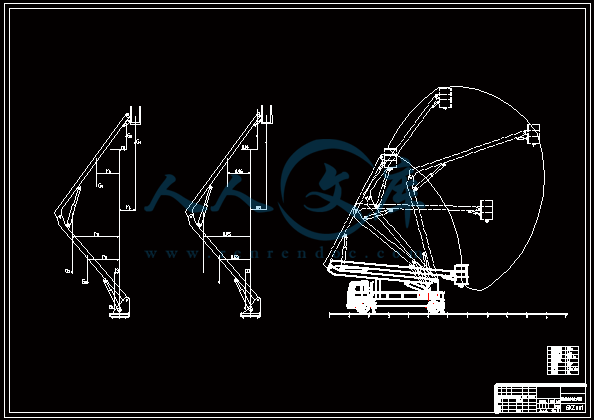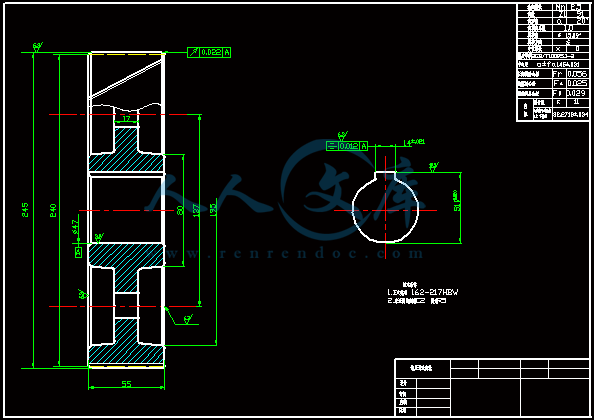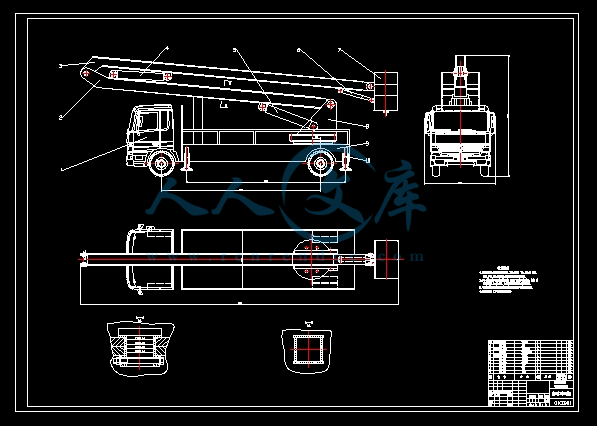资源目录

压缩包内文档预览:(预览前20页/共42页)
编号:6094842
类型:共享资源
大小:3.04MB
格式:ZIP
上传时间:2017-11-15
上传人:机****料
认证信息
个人认证
高**(实名认证)
河南
IP属地:河南
50
积分
- 关 键 词:
-
折叠
高空作业
设计
全套
cad
图纸
- 资源描述:
-










- 内容简介:
-
11Optimal Design of Compliant Trailing Edge for Shape ChangingAbstract: Adaptive wings have long used smooth morphing technique of compliant leading an d trailing edge to improve their aerodynamic characteristicsThis paper introduces a systematic approach to design compliant structures to carry out required shape changes under distributed pressure loadsIn order to minimize the deviation of the deformed shape from the target shape,this method uses M ATLAB and ANSYS to optimize the distributed compliant mechanisms by way of the ground approach and genetic algorithm (GA)to remove the elements possessive of very low stressesIn the optimization process,man y factors should be considered such as air loads,input displacements,and geometric nonlinearities。Direct search method is used to locally optimize the dimension an d input displacement after the GA optimization。The resultant structure could make its shape change from 0 to 93degreesTheexperimental data of the model confirm s the feasibility of this approachKeywords: adaptive wing;compliant mechanism;genetic algorithm ;topology optimization;distributed pressure load;geometric nonlinearity1 Introduction:As conventional airfoil contours are usually designed with specific lift coefficients and M ach numbers,they could not change in accordance with the environment changingSiclari and Austin indicated that the variable camber trailing edge would produce the drag about sixty percent less than the conventional fixed camber airfoilThere are three methods used to design able camber wingsOf themone is conventional hinged mechanism,which,however, will create discontinuities over the wings surface leading to earlier airflow separation an d drag increase The others are smart material and the compliant mechanism,of which both could realize smooth shape changingNevertheless,compared to the compliant mechanism,the smartmaterialmade actuators have many disadvantages,such as deficient in energy ,slow in response,strong in hysteresis, limited by temperature,and difficult to control too many actuatorsMusolff from Industry University of Berlin 12used NiTi shapememoryalloy wire to make an adaptive variable camber wing,which could quickly change its shape,but could not perform highly frequent alteration because of its resilience depend en ton the heat exchange with the outside environment。Compliant mechanism is a kind of one-piece flexible structure,which can transfer motion and power through its own elastic deformationIt is not only flexible enough to deform,but also has enough stiffness to withstand external loadsThanks to its jointfree nature,it does not have the trouble some problems confronted by conventional mechanism such as friction,lubrication,noise and recoiling,thereby achieving smooth shape changing.In 1 994,Kota ,a professor from University of Michigan,firstly pointed out that compliant mechanism could be used to control static shape changing under the sponsorship of the Air Force Of ice of Scientific Research in USASaggere and Kotasuggested a new method to design compliant adaptive structures,which made the least square errors between the shapechanged curve and the target curve as the objective function for optimizationBased on their work,Lu put forward a load pathrepresentation methodHowever, her work was limited to only linear analysis under consideration of nodal loadsGood from Virginia Polytechnic Institute of State University used the compliant mechanism and the Moving Asymptotes method to design the fuselage tail within the allowable range of its tip maximal deflectionKota and He trick in2004 designed a compliant trailing edge on the baseof the F16s data,which can change from 0。to 15。and obtained a patentCampanile from German Aerospace Center presented a modal procedure to design synthetic flexible mechanisms for airfoil shape control,and pointed out that the future research should take into account the air load and the geometric nonlinearityBuhl from Riso National Laboratory of the Wind Energy Department in Denmark used the SIM P method and geometrically nonlinear finite element method to design compliant trailing edge flapsFlxSys Inc in 2006 produced an adaptive compliant wing,which stood the test on the White Knight airplaneThe results 13indicated that the compliant trailing edge could change+10 In China,the research of adaptive wing has been concentrated on smart material and conventional mechanismFew people,it seems,have worked on designing adaptive wings with the compliant mechanismYang is an exceptionHe analyzed the active aeroelastic wings based on the aeroservoelasticity technologyChen and Huang separately investigated the morphing of the compliant leading edge from the viewpoints of discreteness and continuity.This paper presents a method to design the shape changeable structure by MATLAB and ANSYS associated with distributed compliant mechanism on the base of the ground structure approach and genetic algorithm (GA)taking into account the external distributed loads and geometric nonlinearity.2 Optimization Process:21 Defining the trailing edge model and objective functionAs shown in Fig1,both curves represent two ideal shapes of the trailing edge in the different flying statesOne side point)of the structure is supposed to be fixed,and the other side point) to be sliding horizontally. Firstly, the design domain should be defined by the initial curve shapethe input location and the boundary conditionsThenit is divided with abeam element network simulating the birds feather as shown in Fig2This is termed the partial ground structure method.Fig1 Initial shape and target shape Fig2 Discretization of the design domain The simplest and most effective way to manufacture the planar compliant mechanism is to use wirecutting technologyIn the optimization program,all the elements are of rectangular beams with the same width equal to the thickness of the material,every beams height being a design variable14In order to make the structures deformation come close to the target shape curve, the least square error(LSE)between the deformed curve and the target curve is defined as the objective functionLSE is the sum of squares of position differences of various points along the curves Its expression is where I (=1, 2,P)is the number of the points along the curves ,P is the total number of points and are the coordinates of it h node on the target and deformed boundary curve respectivelyThe constraints are Where J (=1, 2, )is the number of elements,miss the tota1 number of elements,h i the dimension variable,h min and hmax are the lower and upper bounds of the element beam height for all elements with the value dependent on manufacturing,h b the height of the boundary elements, the maximumnoda1 deformation of the nodes on the curve boundary when the input point is inactive,and should be smaller thandto ensure structure stiffness,d the allowable maximum displacement when the input point is inactive,Omax the maximum stress of al1 the elements which must be smaller than Tj to prevent yielding,T j the topology variable equal to 1,or else0 when the element is eliminated22 GA optimizationGA is an optimization method which simulates the heuristic selection rule in nature, where the fittest living things have the most chance to survive,but the inferior ones also have the opportunity to exist Different from the continuous optimization method,it does not require the gradient-based information of the objective function.15Every element could be expressed as a topology variable and a dimension variable Therefore,each individua1 could be coded as followswhere ,2 is the number of elements except the boundary onesWith the same heights,the boundary elements throughout the optimizing process arerepresented by only one variable,h b.The fitness is the criterion of the GA optimization It could be transformed from the objective function into where is a coefficient deciding the compulsive selection of the betterindividua1The smaller the value,the more different would be between the two individualsfitness thus increasing the compulsiveness of choosing the individual of higher fitnessThe selection of control parameters plays an important role in the convergence of the GAGenerally speakingthe cross probability ranges 040099;the mutation probability is 0000 01-001and the number of individuals 1 0200The variable would be updated through the crossover and mutation,so the possible design could generate in the GA process23 Finite element analysis(FEA)Because of the limited design variables and the target function,the optimization module of FEA software could not be used to design the compliant morphing mechanismTherefore ,this paper programmed the GA in MATLAB and the FEA in ANSYSIn the FEA,taking only account of geometric nonlinearities and the material being of linear elasticity, ANSYS could solve the node displacements and the element stressesThen by deleting the elements with low stress,the fitness could be calculatedFig3 shows the detailed process 16Fig3 Flowchart of the structural optimization program24 Second optimizationAlthough the GA could optimize the topology and dimension simultaneously in a large solution space,the dimension usually could not directly converge to the optimizationIn order to solve this problem,after the GA,the Direct Search methodshould be used to find the best values of the input displacement and the dimensions of the elements which remain in the results after the GAFor morphing of compliant mechanism,Fig3describes the whole optimization processIt mainly contains initialization of the design domain,FEA ,GA optimization and second optimization.3 Presentation of Results:Adopted from Ref,the sizes of the initial and the target trailing edge are reduced by sixty percent ,I1ab1e 1 lists the design parameters.Because the displacement is used as the input,the nonlinear analysis could hardly converge and the stress of the initia1 solutions is very largeWhich should be considered after thirtieth generation.17Table 1 Design parameters Fig4 and Fig5 illustrate the results from the GA optimization and the second optimization respectivelyFig4 Results after the GA optimization Fig5 Results after the second optimizationForm Table 2,it could be found that through the second optimization of the input displacement and the dimension,the LSE is reduced by 1352 8mmand improved by 313 The altered angle is increased by 1049 3Table 2 Results after the two optimization 18Fig6 Stability of final optimal structureFig6 shows the influences of the parameters when the outside distributed pressure load changes from 0 to 1 0 Nmm and the input displacement remains 1 1389 7 mm on the optimal structureIt could be seen that the optimal structure has a good stability if the load is kept in the range Of 05 NmmAs the external load exceeds 5 Nmm,the max stress is likely to exceed the yield stress19Because this optimization program is based on the M ATLAB and ANSYSin order to verify the results an attempt is made to introduce the analytical results of the optimized structure into ANSYS and PATRAN respectively, and then a comparison is made between themAs shown in Fig7 and Fig8,the two altered shapes are in good agreement:for in ANSYS the tip displacement is 5497mm and in PATRRAN 5450mmThe minor difference between them is from the softwareFig7 Results of FEA in ANSYS Fig8 Results of FEA in PATRANOn the other hand,a model is made by wirecutting technology to verify the analytical resultsThe material of the mode1identical with that of the design,is 5 mm thickIn the experiment,the distributed pressure load is assumed to be zero The input displacement 11389 7mm with the required input load 146 NFig9 shows the model and the experimental resultThe altered angle is measured93 。 and the tip displacement 53mmThe altered shape well accords to the optimized resultIf a displacement of 113897mm is imposed on the model,the theoretical tip displacement is 54796 mm Because of the friction there is between the model and the experiment table a tiny difference will take place between the measured data and the calculated results20Fig9 The model and experimental result4 Conclusions:Proved by the simulation and experiments,the proposed method to design morphing compliant mechanism is effectual in turning out a trailing edge with required morphing effects and ability of withstanding external loadsThe combination of MATLAB and ANSYS in the optimization renders the program simple and universa1There is no need for frequent changes of the rigid matrixIt also avoids the complexity of programming the nonlinear FEA and the transforming distributed loads into nodal loadsUsing the mixed code,the topology and the dimension could simultaneously be optimized by the GARemoving the free elements after the FEA could speed up the optimizationThe second optimization could improve the GA results1符合尾随边缘形态变化的优化设计摘要:自适应机翼一直使用柔和的技术指导变形的后缘,以改善他们的气动性能,本文介绍了一种在分布压力下,符合形状 变化的结构设计的系统化方法。 为了使需要的形状与目标形状偏差尽量最小,这种方法使用 MATLAB 和 ANSYS的方式来优化标准分布机制。这种方式通过局部优化和遗传算法来获得。在优化过程中,许多因素应该考虑在内,例如:空气 载荷、输出位移量和几何非线性。直接搜索法适用于局部优化和 GA 优化后的输入位移量。由此产生的结构可以做出他们在 0 到 90。.之间变化,模型试验已经确认了这种方法的可行性。关键词:自适应机翼,伺服顺从机构, 遗传算法,拓扑最优化,分布压力载荷,几何非线性1说明由于传统的机翼轮廓通常是按照特定的上升系数和马赫数设计的。他们不能随着环境的变化而变化。Siclar 和 Austin 指出可变 的后缘曲面将会产生比传统的固定倾角机翼少 60%左右的阻力。有三种去设计可变的曲面机翼的方法。他们中的一种是传统的铰链机构,然而,他会导致机翼表面的不 连续性和早期气流分流与阻力的增加。其它的则是智能材料和顺从机构,他们能 实现平稳的形状变化。尽管如此,与顺从机构相比较,由智能材料制成的传动装置有许多不足之处。例如:能量不足;反应缓慢;强烈的滞后性;受温度的限制;控制太多装置的难度大。由来自柏林工业大学的用镍钛记忆合金作出的自适应可变拱形的机翼可以快速改变他的形状,但他不能执行高频繁的变化,因为他的弹 性依赖于与外部环境进行的热量交换。顺从机构是一种单件灵活的机构。他可以通过弹性变形传送运动和能量。他不仅具有足够的变形性,而且具有足 够的刚度来抵御外部的载荷。由于他的连接自由性,他没有传统所面临 的棘手问题,例如:摩擦、 润滑、噪声、反冲。因此可以获得平稳的形状变化。1994 年,一位来自密歇根大学的名叫 kota 教授首先提出顺从机构能够使用在一项由美国空军科学研究院办公室提供赞助的控制静态形状的科学研究之中。Saggere 和 Kota 提出了一种设计顺从机构的新方法,他们能够使优化目标函数曲线中的形状变化和目标曲线的形状误差最小,基于他们的研究成果,Lu 提出了2一种载荷路径代表方法。然而,他的研究仅限于节点情况下的线性分析。来自于福尼亚州立学院的 Good 使用顺从机构和运动渐近法来 设计机翼的尾部,保 证误差在尖端最大偏差范围之内。基于 F16 的数据,Kota 和 Hetrick 在 2004 年时间设计顺从轨迹边缘,他能在 0。到 15。之间变化并且获 得了专利证书。来自德国航空航天中心的 Companaile 提出了模 拟静态程序设计机翼形状控制合成灵活机构,并指出今后的研究应将空气载荷和几何非线性考虑在内。来自工业能源部实验室的 Buhl 使用 SIMP 法和几何非 线性有限元法来设计顺从轨迹边缘。 Flxsys Inc在 2006 年生产的自适应兼容机翼。经过了在怀特骑士飞机上的实验。结果表明,风和标准的能在(-10 。10。)变化。在中国,适应性机翼研究一直集中在智能材料和常规机构上,几乎没有人在从事带有顺从机构的机翼研究上。杨是个例外,他分析了基于伺服弹性技术的活跃航空弹性机翼,陈和黄分别调查了兼容的离散和连续性的前沿变化。本文介绍了一种基于局部优化和遗传算法形状可变机构的设计方法,通过使用 MATLAB 和 ANSYS设计,同 时将外部载荷和几何非线性考虑在内。2优化步骤2.1 确定后缘模型和目标函数如图一所示,两条曲线代表不同飞行状态的轨迹边缘。其中一边(A 点)的结构形状是固定的,另一边( B 点)将水平滑 动。图一 图二 首先设计领域应该由最初曲线形状所定义,包括输出位置和边界状态,然后如图二所示的被光线分成的微量网格模仿鸟的羽毛部分,这就是被称为局部表面结构方法。3最简单也是最有效的方法制造出平面兼容机是使用线切割技术。在优化过程中,所有的元素使用同样 的宽度等于其厚度的梁。其中每个梁的高度是一个设计变量。为了使结构的变形接近于目标曲线形状,在变形曲线和目标曲线间的最小平方差是被定义的客观职能。 LSE 的定义是沿曲线上各个点位置数字的平方和,他的表达式是 其中 i(i=1,2,,p)是沿曲线上点的数量,p 是点的总数。 和是目标和边界曲线变形坐标的第 i 个节 点。约束条件是:其中 j(j=1,2,,m)是元素的数量的总和,h i 是尺寸变量,h min 和 hmax 是所有元素的下界与上界,h b 是边界元素的极点,d max 是党边界曲线上输入无效节点时的最大弯曲,必须小于 d 以保证结构的刚度,d
- 温馨提示:
1: 本站所有资源如无特殊说明,都需要本地电脑安装OFFICE2007和PDF阅读器。图纸软件为CAD,CAXA,PROE,UG,SolidWorks等.压缩文件请下载最新的WinRAR软件解压。
2: 本站的文档不包含任何第三方提供的附件图纸等,如果需要附件,请联系上传者。文件的所有权益归上传用户所有。
3.本站RAR压缩包中若带图纸,网页内容里面会有图纸预览,若没有图纸预览就没有图纸。
4. 未经权益所有人同意不得将文件中的内容挪作商业或盈利用途。
5. 人人文库网仅提供信息存储空间,仅对用户上传内容的表现方式做保护处理,对用户上传分享的文档内容本身不做任何修改或编辑,并不能对任何下载内容负责。
6. 下载文件中如有侵权或不适当内容,请与我们联系,我们立即纠正。
7. 本站不保证下载资源的准确性、安全性和完整性, 同时也不承担用户因使用这些下载资源对自己和他人造成任何形式的伤害或损失。

人人文库网所有资源均是用户自行上传分享,仅供网友学习交流,未经上传用户书面授权,请勿作他用。
 川公网安备: 51019002004831号
川公网安备: 51019002004831号